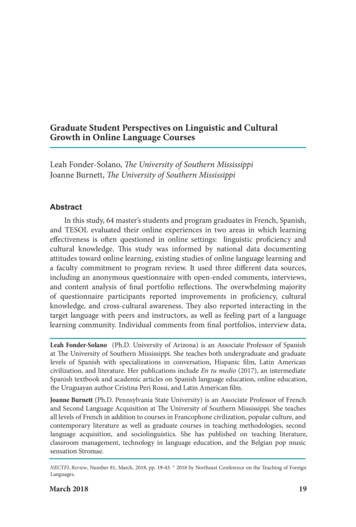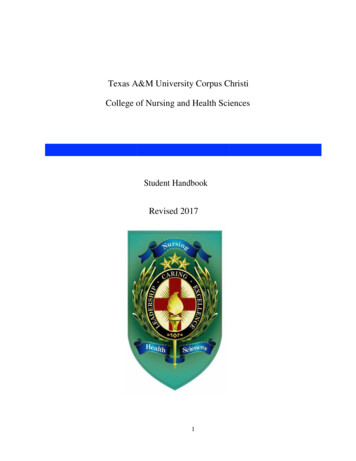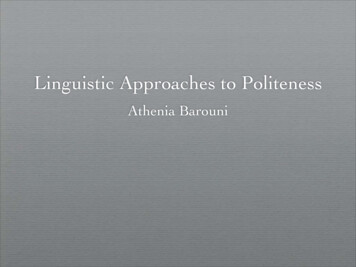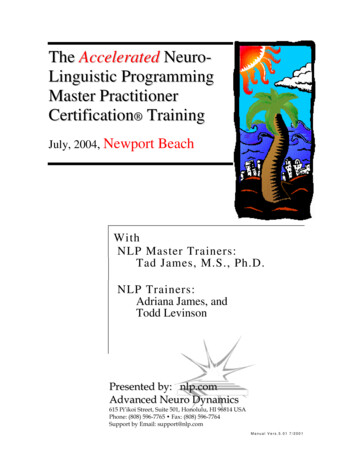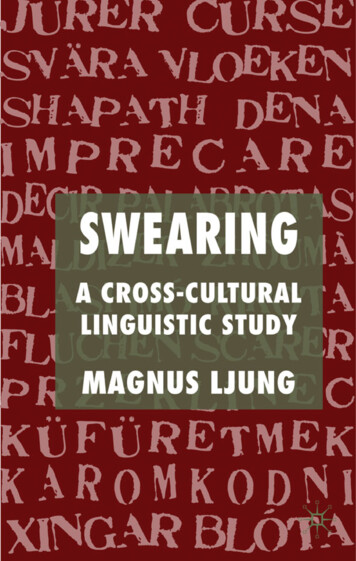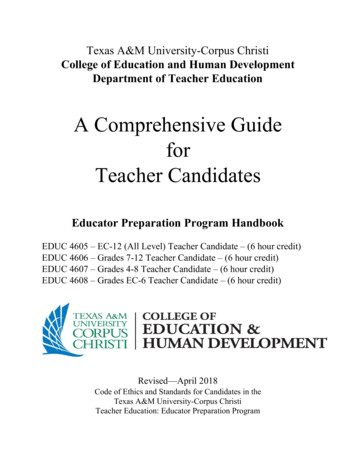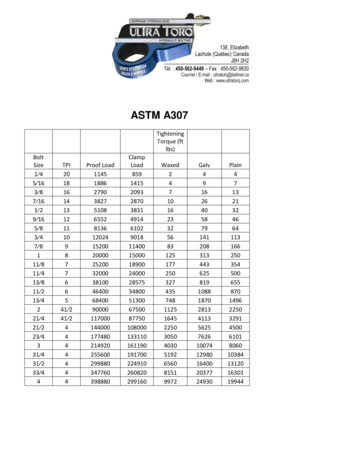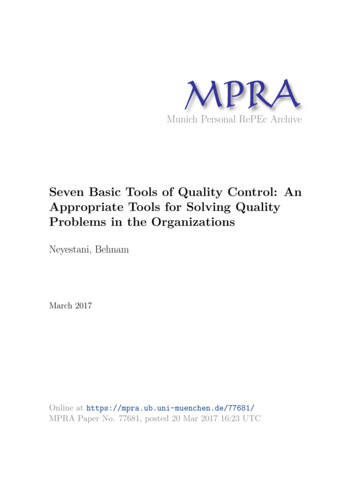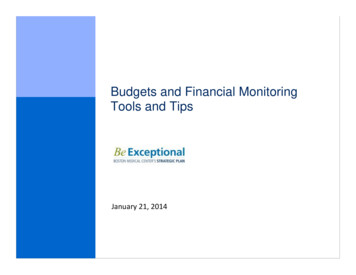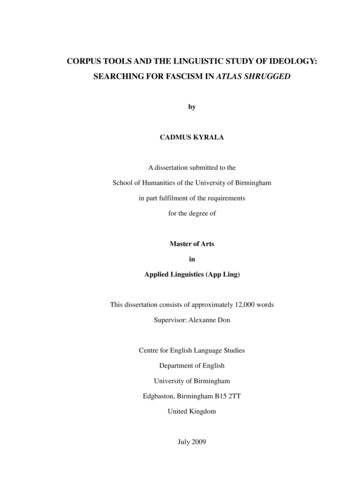
Transcription
CORPUS TOOLS AND THE LINGUISTIC STUDY OF IDEOLOGY:SEARCHING FOR FASCISM IN ATLAS SHRUGGEDbyCADMUS KYRALAA dissertation submitted to theSchool of Humanities of the University of Birminghamin part fulfilment of the requirementsfor the degree ofMaster of ArtsinApplied Linguistics (App Ling)This dissertation consists of approximately 12,000 wordsSupervisor: Alexanne DonCentre for English Language StudiesDepartment of EnglishUniversity of BirminghamEdgbaston, Birmingham B15 2TTUnited KingdomJuly 2009
ABSTRACTAdvances in computers have revolutionized corpus linguistics. Texts which coulduntil recently only be examined in part, due to size, can now be quickly and thoroughlyscanned for specific linguistic elements. Recent studies have begun integrating corpuslinguistics with CDA in the interest of assessing large volumes of text for ideologicalcontent. It has been claimed that Atlas Shrugged reflects a fascist ideology. The presenceof fascist ideology was assessed using corpus tools and analysis of significant features incontext. A corpus of Nazi texts was compiled to compare ideological elements. The Bankof English was also used as a comparison. Corpus tools were not sufficient in themselvesto provide a complete picture of ideology. However they did facilitate comparativekeyword and collocational analysis and also the screening of Atlas Shrugged for the use ofpassive voice, ergative verbs and negation. Results were then investigated in context toascertain their ideological impact. Key elements of fascism were not substantiated. Use ofconcealed agency did not reflect mitigation of ideological content. Negation, whilepresent, could not be assessed in a purely linguistic study. The ideology was found to beexplicit, not concealed, and not indicative of fascism.
This dissertation is dedicated tomy wife Eiko.Without her patience, love, and understanding I could not have written it.
CONTENTSCHAPTER 1INTRODUCTION1CHAPTER 2THE LINGUISTIC STUDY OF IDEOLOGY4CHAPTER 3USING CORPUS TOOLS AND CDA TO DETECTIDEOLOGY13CHAPTER 4LINGUISTIC ANALYSIS FOR ELEMENTS OFFASCIST 254.4Strong State / Anti-democracy284.4.1Law & Order294.4.2Militarism314.4.3Anti-pluralism and Anti-democracy324.5Agentless Processes (Ergative Verbs and the Passive Voice) 334.6Negation354.7Summary37VALIDITY AND RELEVANCE385.1A Valid Basis of Comparison385.2How this study contributes to the debate over40CHAPTER 5Atlas ShruggedCHAPTER 6CONCLUSION43APPENDIX 1Full List of Texts Used in Nazi Corpus46
APPENDIX 2Full Frequency List of Terms Relating to Nationalism49APPENDIX 3Full Frequency List of Terms Relating to Racism50APPENDIX 4Full Frequency List of Terms Relating to Xenophobia52APPENDIX 5Full Frequency List of Terms Relating to the Strong State /Anti-democracy53REFERENCES56
LIST OF TABLESTABLE 1Frequency List of Significant Terms Relating to Nationalism18TABLE 2Collocation Pattern for “country” in AS19TABLE 3Concordance lines of “best” and “country” in AS20TABLE 4Collocation Pattern for “country” in NC21TABLE 5Concordance lines of “love” and “country” in NC21TABLE 6Concordance lines of “mother” and “country” in NC21TABLE 7Frequency List of Significant Terms Relating to Racism22TABLE 8Eye colors and Character Nature24TABLE 9Frequency List of Significant Terms Relating to Xenophobia26TABLE 10 Frequency List of Significant Terms Relating to Strong State /28Anti-democracy ElementTABLE 11 Concordance lines of “order” in AS30
CHAPTER 1: INTRODUCTIONAyn Rand‟s Atlas Shrugged (1957) (henceforth AS) has been the subject of a greatdeal of controversy since its publication in 1957. Since initial allegations of masking a fascistideology (Chambers 1957), and despite a series of philosophical and political rebuttals (Uyl &Rasmussen 1984; Tracinski 2005, Berliner 2007) the charges of fascism remain noticeablyactive as evidenced by a variety of recent reviews of the work in the general media and on theInternet (Cline 2006, Teachout 2007, Larner 2007, Gibson 2009). In the context of thiscontroversy, it seemed appropriate to analyze AS and search for any linguistic elements thatcould give rise to such an impression. What follows is a corpus based analysis of thelinguistic features of the book with a specific focus on examining claims of the presence offascist ideology in the text of Ayn Rand‟s Atlas Shrugged (1957). It is hoped that this analysismay help to inform a model of examining literary texts for ideology.Chapter 2 provides a brief history of the study of ideology in the field of linguistics.The academic foundations of the use of corpus analysis to assist in the ideological analysis oftexts are traced from Saussure‟s initial definitions of the interplay between society andindividual actors in the creation of language to recent studies which attempt to incorporateCritical Discourse Analysis (CDA) with corpus technology to aid in the detection of specificideological trends. It is suggested that there is substantial theoretical support to justify the useof corpus tools to search for key structural elements that may, upon closer inspection, revealideology inherent in a given text.Chapter 3 will explain the method of the analysis. AS was compared to a generallyrepresentative corpus of the English language. In order to form a baseline of comparison, acorpus of Nazi texts was also compiled and compared against the same general corpus. Wordswhich appeared at a significantly higher frequency in either AS or the Nazi corpus (hereafter1
NC), were then noted as possibly significant of represented ideology. A scholarly definition ofthe essential ideological elements of fascist ideology was then used to select for potentiallyideologically significant terms which could then be checked for possibly informativecollocations or be examined more thoroughly in context. The use of concealed agency wasalso investigated by using the corpus to assist in searching for use of the passive voice andergative verbs. Finally, the use of negation in the novel was examined by searching for termsindicating negation and then examining those instances in context.Chapter 4 presents the results of the analysis. A keyword analysis of elements offascism (nationalism, racism, xenophobia, and statist, anti-democratic discourse) revealed nosignificant indications of the presence of fascist ideology in AS. In contrast, all lexical itemssuggestive of fascist ideology were significantly present in the NC. Concealed agency wasshown to be a recurring device in the novel, but one used consciously and to stylistic effect,underscoring the author‟s explicit opinions concerning its use. The ideology indicated by suchuse did not seem indicative of fascist ideology. Negation in the sense of creating a dichotomybetween morally polar opposites was highly present in the novel. However, it did not seem tobe used in such a way as to suggest that the constructed sense of positive-self andnegative-other representation was distinguished on characteristics indicative of fascistideology.Two central issues raised by the analysis are discussed at length in Chapter 5.Possible concerns about the relevance of the NC as a basis of comparison to detect fascistideology are addressed. It is argued that as a source of ideological indicators, NC is sufficientto prove or disprove a correspondence of ideological content despite differences in genre.Finally, the controversy over AS is discussed. This paper is contextualized within the debateover the charges of fascism. The possible relevance of this paper for informing this debate is2
then assessed.It would seem that corpus analysis is not sufficient in itself to provide a thoroughpicture of the ideology of a text. However, it can provide clues as to patterns of preoccupationin choice of lexis, which can lead to the investigation of lexis in context to determine thesense in which it is used. Corpus analysis can also inform about collocational patterns whichmay be invisible to a traditional literary analysis. Finally it can assist in the statistical analysisof structural features dependent on specific lexical items. The results of corpus analysis do not,however, directly inform as to the veracity of an ideology, something which can only beassessed in a primarily philosophical and not linguistic argument. Nevertheless, corpus toolscan provide leads to follow which, having been examined in context, can then enable us toreadily determine what ideological features are presented and confirm or deny the existenceof a given ideology in a given text. This, of course, assumes that both an accepted definitionof the ideology is available and that a corpus of texts representative of that ideology isavailable for cross-comparison. Having analyzed AS in this manner, and using the NC as arepresentative comparison, it is argued that fascist ideology while confirmed in the NC isseemingly not present in AS. It is hoped that studies of this kind may provide relativelyobjective tools to assess the ideology of controversial texts.3
CHAPTER 2: THE LINGUISTIC STUDY OF IDEOLOGYThe history of modern linguistics is intricately connected with the study of ideology.This chapter will attempt to justify the theoretical foundations of the current study in terms ofthe history of the involvement of linguistics research in ideological studies. Of specificimportance is the justification of using corpus analysis to expose the ideology of a text andthe conditions under which it is acceptable to do so. Consequently, the theoretical lineage ofideas which support such studies is also necessary. It is argued that the current study iscompatible both with current research into the coordination of corpus analysis with CDA andthe broader scope of linguistic studies of ideological content. A review of these studies wouldseem to indicate the framework for a model of analysis which may provide insight into theideological content of a text. This may be an especially useful tool in cases where theideology expressed by a given text is the subject of controversy, as in AS.Recently, Baker, et al. (2008) have advocated a synergy between critical discourseanalysis (CDA) and corpus linguistics. Building off of a series of recent ideological studies ofdiscourse incorporating corpus tools (Baker 2004; Baker & McEnery 2005; Orpin 2005;McEnery 2006), they utilized a combination of corpus linguistics and CDA to analyze a largecorpus of newspaper articles for ideological perspectives of refugees, asylum seekers,immigrants, and migrants (RASIM). They verified that the corpus analysis complemented theresults of the CDA analysis and in fact expanded upon it by revealing the presence of positiveminority views of RASIM, whereas the CDA analysis did not (Baker, et al. 2008). They alsomade specific recommendations for the role of corpus linguistics in CDA. They suggest thatcorpus linguistics can be used to “provide a general „pattern map‟” of a large volume of data.First, it can provide information on which lexical items appear at a disproportionate frequencyas compared to a general corpus. These keywords can then be checked for collocations which4
may yield additional insight into the preoccupations of the authors. Finally, concordances ofinterest can be examined closely to verify the context of statements and the linguisticelements involved.The current study was constructed along similar themes. Using a general corpus as astandard of normal usage, AS and the NC were both compared against a general corpus toprovide evidence of preoccupation with certain themes. The specific themes to be investigatedwere drawn from a survey of academic definitions of fascism. The keywords and collocationsproduced from this comparison where then examined in context to assess the ideologicalintent of the occurrences. Corpus analysis was useful in identifying comparatively highfrequency words in both AS and the NC which, once checked against the academic definitionof fascism, could then be investigated using a concordancer to check for collocations. Alsothe corpus tools enabled the relatively timely evaluation of structural elements such as thepassive voice or ergative verbs and the presence of negation. However, to better understandthe validity of this research method, it is first necessary to review the chain of linguisticresearch that has led to the current study.In the early 1900s, Ferdinand de Saussure originated what he called “semiology, „thelife of signs in society‟” (Kress & Hodge 1979: 10). He held that a langue is held together bysocial forces and does not readily change, but that small gradual changes in parole, or the useof language by individuals, can eventually force a change in langue. Saussure maintained theabsence of political design in this system and asserted that all individuals have equal access(Joseph 2006: 64). The potential impact of a concerted and politically motivated secondaryinfluence on langue by consciously influencing parole, while dismissed by Saussure, is stillsuggested by his work. It is also a suggestion of the subtle and perhaps not readily apparentinterplay of ideology with the changing interpretations of language in use.5
In 1929, Valentin Voloshinov criticized Saussure for ignoring the ideological natureof signs. He emphasized the Marxist school of thought which interpreted language in terms ofclass struggle.“Signs are ideological by their very nature, and social existence is not merely reflected in them but„refracted‟ by them No speech act is individual; they are always social, even if the addressee existsonly in the speaker‟s imagination” (Joseph 2006: 65).This idea was highly influential in the development of the study of ideology inlanguage, but his writings were not largely available outside the Soviet Union until the 1960sby which time other researchers had reached similar conclusions independently (Joseph 2006:65). The social semantics of J.R. Firth, for example, de
Ayn Rand‟s Atlas Shrugged (1957) (henceforth AS) has been the subject of a great deal of controversy since its publication in 1957. Since initial allegations of masking a fascist ideology (Chambers 1957), and despite a series of philosophical and political rebuttals (Uyl & Rasmussen 1984; Tracinski 2005, Berliner 2007) the charges of fascism remain noticeably active as evidenced by a variety .
